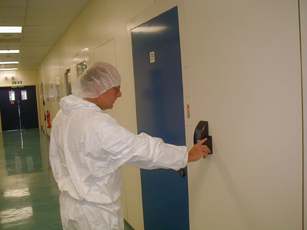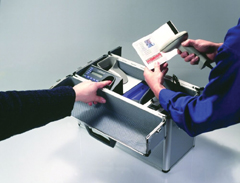By Brian Rose
|

|
|
The use of fingerprint readers for door access is increasing. (Photo by TSSI) | The market for Fingerprint Readers for Access Control splits into 2 major segments:
The first major segment is devices that can be fitted as a replacement for a door handle mechanism. So far the market for such devices has been restricted to hotels and some residential use. The price pressure on these products is intense, and consequently product quality comes a poor second to product cost.
The second major segment is packaged devices that can be fitted to a wall adjacent to the door to be controlled. This article is restricted to a global view of these devices.
A GLOBAL BUSINESS
The manufacture of fingerprint readers is a truly global enterprise with companies in Europe, the U.S.A., Asia, Africa and South America all producing various units. The majority of manufacturers produce devices to a specification similar to that defined below:
-
A boxed device of an appropriate size and shape for wall mounting
-
Normally fitted with an LCD display of 2 lines of 16 characters or more
-
12V DC power input - To avoid the manufacture of multiple devices for different markets
-
Fitted with an integral door control relay
-
Permitting the attachment of an external reader - Although units with built in keypads, proximity card readers or smartcard readers are also common.
-
Capable of outputing a PIN in either clock and data format, or one of the many wiegand formats
-
Fitted with one or more communications interfaces, which may be RS232, RS485 or TCP/IP
-
Fitted with onboard memory capable of storing from 200 to 5,000 templates
-
Fitted with either an optical or a semiconductor sensor to scan the Fingerprint. Whilst not as durable as optical sensors, semiconductor sensors do offer cost and size advantages, and are appropriate in low usage applications where vandalism is not a problem. The majority of devices scan to a resolution of 400 to 500 dpi. This is considered the minimum acceptable resolution as lower resolution devices are compromised by the Nyquist limit. The Nyquist limit is approached when sensors of 250 dpi or lower are used by populations with tightly spaced Fingerprint ridges -- examples of these populations can be found in many Asian countries, and with children all over the world.
TYPES OF USE
Fingerprint Readers can be used in 2 ways:
As stand-alone units where the integral door control relay directly controls one door. This type of use is common in small installations where a full Access Control System is not installed.
As input devices for Access Control Systems; here the function of the Fingerprint Reader is to act as a Biometric switch that only sends the PIN to the Access Control Systems on a successful Fingerprint pass, that is after verifying the identity of the user. The Access Control System then decides if the user has the correct Time and Access rights to enter through the door. For example, Mr. A may only be allowed to enter the computer room between 08.00 and 17.00. At times outside of this range his finger will still pass on the Fingerprint Reader, but the Access Control System will deny him access.
The important word in the last paragraph is ¡±Verify¡±. The user claims an identity by offering a PIN. His finger is then checked against the template stored against that PIN, if successful he is verified. Devices do exist that can perform identification. This is where no PIN is offered, but a finger is just placed on a sensor. The device then needs to check this finger against all the stored templates. Identification is of limited use in commercial applications as processing speed is usually slower, maximum template capacity is lower, and device cost higher. Identification is also inappropriate in ¡±Mixed¡± systems where some biometric devices are used to control just a few of the total number of doors in a company. An example could be a company with a total of 50 doors in its offices, out of these 40 are controlled by keypad or card readers, the rest such as computer rooms, cash office, Personnel Offices, Directors offices, etc. are controlled by keypad or card readers plus a Fingerprint Reader. In this type of system the same PIN or card can be used every where.
TRAVEL WITHOUT HASSLE
|

|
|
Perhaps the lowest cost option to store a template on card is to encode the template or templates into a 2d barcode format such as PDF417 and print it on a cheap plastic card. (Photo by TSSI) |
It is now common to see multiple Fingerprint Readers in use at one location. To avoid enrolling people at every reader most manufacturers offer some form of networking to allow the exchange of templates between units. This may be a dedicated RS485 network, or TCP/IP interfacing to allow communication via a LAN. Typically up to 128 Fingerprint Readers can be interconnected.
To avoid the infra structure and management of networked Fingerprint Readers many organisations are now choosing the convenience of template on card. Here the template or templates are stored on a card, and as the template travels with the user networking is not required.
There are several ways to store a template on card. Perhaps the lowest cost option is to encode the template or templates into a 2d barcode format such as PDF417 and print it on a cheap plastic card. This results in minimal card costs and is ideal for applications where a large mobile population has to be enrolled. Examples of this type of application are Alien registration documents in countries such as Nigeria.
Another low cost option for template on card is the use of Magnetic swipe cards. Typically a PIN is written on Track 2 of the card, and Track 3 remains unused -- allowing up to 85 bytes for the storage of a template.
At the top of the cost pyramid for template on card is the use of Smart Cards as a platform. While it is perfectly possible to produce a template on card system using Contact Smart Cards, in practice these are seldom seen as insertion/read time and contact wear are problem issues. A number of companies offer solutions based on Mifare, Legic, HID i-Class , and Texas Instruments cards. These applications favour wireless non-contact cards operating at 13.56MHz. Here a PIN is encoded on one area or sector of the card, and a template is encoded on another area or sector. Some companies achieve template storage in just one area or sector, others need 7 or more contiguous areas or sectors.
WHO ARE THE MARKET LEADERS?
Whilst this article has concentrated on Fingerprint Readers for door access another common use is for Time and Attendance, and the dividing line between the 2 applications is becoming increasingly blurred. Because of this many companies produce Fingerprint Readers suitable for either purpose.
This article would not be complete without a few examples of Fingerprint Readers from around the world:
Whilst a variety of Fingerprint Readers are available from the U.S.A., there is significant product availability from Asia, Europe, Africa and South America. In Asia one of the leading producers of Fingerprint Readers is Nitgen in Seoul, Korea, whilst TSSI in the U.K. have been producing innovative Fingerprint Readers since 1997. Another U.K. company that is active worldwide is Feedback Data. In South Africa two interesting leading producers of Fingerprint Readers have emerged; Trac-Tech in Cape Town and Siemens-Redelec in Johannesburg, both producing devices that provide combined door access and Time and Attendance capability. Their products have found acceptance in mines, shops and various industrial applications. In South America the dominant company is Topdata who operate from Curitiba in Brazil. Topdata products, are being widely used in Brazilian ports to control access in fulfillment of the International Ship and Port Facility Security (ISPS) Code. Once again this is a company convinced of the need for Fingerprint Readers with both door access and Time and Attendance capability.
WHAT TO EXPECT FROM FINGERPRINT READERS
Such products illustrate the increasing sophistication of the Fingerprint Reader market, showing product capabilities matched to varying user requirements. Today we can identify three main application areas, together with variants and combinations of all three.
One of the simplest applications for Fingerprint Readers is door access without the use of a central Access Control System, performing the simple function of entry control. Logging of transactions is not common for entry-level products, but some manufactures do offer Transaction Logging options, hence an audit trail can be saved showing who accessed the door and when.
A more sophisticated application for Fingerprint Readers is door access combined with the use of a central Access Control System. Such as combination allows the setting of both time and access rights, together with Logging of transactions, and in some cases real time visibility of who is entering which door.
A further application for Fingerprint Readers may be to combine entry to a factory or office area with Time and Attendance. Here security and accounting come together : security - restricting access only to permitted persons, accounting - monitoring the start and finish times in order to generate payroll information.
USABILITY COUNTS
Whilst there is a variety of Fingerprint Readers on offer the choice of one suitable for the intended application is crucial, and good advice from a committed manufacturer can be worth its weight in gold. Often the technology is only part of the solution, and the installation of Biometric technology can easily be spoilt by a poor introduction process. It takes time and experience to produce useable Fingerprint Readers -- and in terms of product quality you get what you pay for!
Brian Rose is Product Manager of TSSI (www.tssi.co.uk)
For more information, please send your e-mails to swm@infothe.com.
¨Ï2007 www.SecurityWorldMag.com. All rights reserved.
|



